What Does It Mean to Say That Art Is Subjective? Select the Best Answer
Reading the previous chapter volition brand this text much more understandable, but if yous really must skip it, here's some context: I decided that the best way to explain what is art is to understand some history, some philosophy and some technique.
Not because it'll give you a clear answer, but considering it will provide you with some legitimate critical thinking. And then, who knows, you might even have informed opinions.
Then, what is Art?
After many centuries of artistic periods being defined by political, social and economic contexts and not then much past individual gustatory modality, there was a gradual shift in how data was acquired and shared.
The scientific method solidified the acquisition of knowledge and the Industrial Revolution changed the mural of how humans lived and worked. The consequent genesis of a heart class made way for the education of many more people - catastrophe some of the elitism that defined education so far.
I lives longer, one lives ameliorate, i knows more than and inventiveness is born. That'southward what happened to way more than people than in previous centuries that were either defined by scarcity, state of war, and/or religious extremism.
This was how art became more democratic and, consequently, more available to individual, personal and emotional expression.
Zeitgeist
Zeitgeist is the dominant set of ideals and beliefs that motivate the actions of the members of a gild in a particular period in time and it translates literally from German as "fourth dimension mind" or "fourth dimension spirit".
Georg Hegel never actually used this discussion but, in his works, such as Lectures on the Philosophy of History, he says the following:
"No homo can surpass his ain fourth dimension, for the spirit of his fourth dimension is as well his own spirit." - Georg Hegel
This idea is closely related to the way Hegel saw fine art. In this prototype, any the artist creates volition reflect the culture of that given time. The creative person is an unavoidable product of that time and, therefore, will bring that culture to his/her art.
The Zeitgeist theory starkly positions itself against a 19th-century theory by Thomas Carlyle called The Nifty Man Theory, where individuals possess the characteristics that turn them into great leaders.
These characteristics, combined with divine inspiration, will allow them to obtain positions of power and, consequently, shape history.
"The history of the earth is just the biography of keen men." - Thomas Carlyle
Tolstoy was having none of that and, in his book State of war and Peace, he considers the significance of cracking individuals imaginary: they are mere slaves of history. Herbert Spencer went as far equally saying he considered Carlyle'due south ideas to exist hopelessly primitive, childish and unscientific.
And truthfully, the Great Man Theory does residuum on the assumption of inconsequential and innate skills, disregarding the large jigsaw puzzle that constitutes our Universe. It ignores how everything is a consequence, of a outcome, of a issue.
And allow'southward not even get into the concept of "free will" in this post - we have to picket out for this rabbit hole.
This basically means that logically speaking, art cannot possibly be this esoteric thing that spawns out of amazingness of certain individuals, or is born out of pure bliss, amazing "talent" or innate skill of some really lucky people.
One could even say that "skill" is a very relative concept in what comes to art. It implies technical mastery, but different levels of technological knowledge have shaped art since its very beginning, and that's why "skill" or "technique" are very flaky standards for quality.
Fine art vs Craft
Let's take a very bones concept like linear perspective or, only put: the way objects appear to be smaller when more than afar.

Its study and geometric exploration within visual representation only commenced in the fourteenth century during the Italian Renaissance, and it still took some time until it was perfected and properly understood.
This technical understanding became credible in all artistic work from then onward, whilst all the graphical works that were beingness produced earlier that time preserved this virtually bizarre aura of failed attempt at being tridimensional.
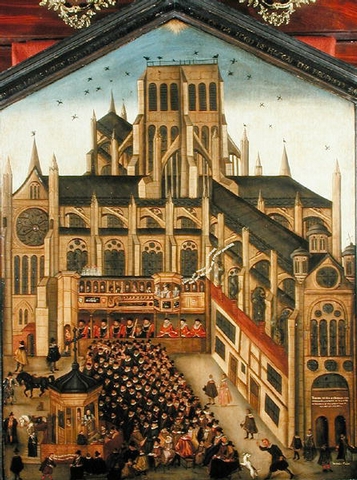

But was it failed? Or was information technology that, at that point, realism in representation was only not a canon? What came first: the need for realistic graphical representation, or the techniques that allowed it to exist produced? Does it matter whether one is creating out of capability or out of choice? Is technique a standard for quality in Art?
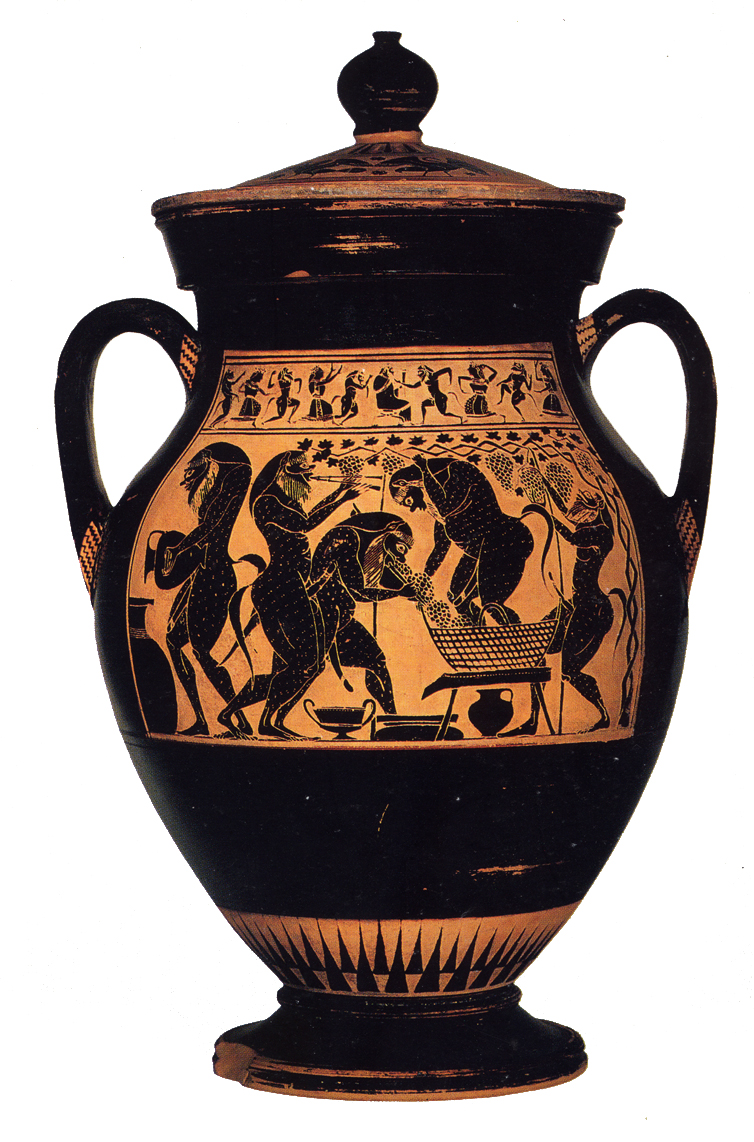
So take Greek vases. They are black with deep orange figures and adornments. It's considered by many a beautiful art piece with a great color combination that has a minimalistic yet mystic and immersive effect, achieved through the stories that their images tell.

And then there's Chinese porcelain. It'due south ** colorful, delicate, its drawings are rich in item and their figures transport us to a culture that is filled with interesting mythology.**
Unfortunately, I haven't studied them as deeply as the Hellenistic Civilisation, so there'southward non much I tin tell y'all about these vases' when'south and why's.
Merely I can tell y'all this much: the Greek vases are blackness and deep ruby not thanks to ink, but cheers to a material that when practical to their surface turns the dirt into black afterward cooked. In that location'due south no color picking involved.
Did the technique dictate the aesthetics or was it the other way around? Was information technology a cocky-imposed limitation, or did the technical limitation generate the fashion? Is the Chinese porcelain superior considering its defining characteristics are the effect of a more versatile and technically advanced technique? Is one more than art and so the other?

Finally: did Pablo Picasso paint a woman this way because he didn't know how to do it in a realistic fashion, or by choice? I can tell you lot that he knew very well how to exercise realistic painting (come across image below), but is the presence or absenteeism of choice some sort of validation for creative expression?

That's a dangerous principle to follow, because it can invalidate any work done under whatever constraints that might limit free pick, like technical knowledge, money, fourth dimension, and more. If you look back at all you've learned about history of fine art so far, you'll discover that everything has constraints, and that fine art has been shaped by materials, techniques, religion, order, and many more. All accept been shaped by Zeitgeist.
Using absenteeism or presence of choice as a standard for quality means invalidating many pieces throughout modern and aboriginal history. Fine art pieces y'all had no idea how messed up their process were - from technical limitations, material limitations, budget, personality misalignments, to even mental health issues if you want to go there.
So passed this Historic period of Enlightenment (whose finish started at the beginning of the 1800s), we entered the relativist thought and there was no more than craze for a "realistic" graphical representation of the world. And that'south when art becomes trickier.
Extremely Brief History of Modern and Contemporary Art

Remember the Romantic menstruation where they were all about nostalgia, romanticism, epicness and connexion to nature and history?
A couple of years passed and some painters decided to focus on the relatable reality of everyday life during a motility chosen Impressionism. Boiler could be beautiful and worth contemplating through poetics of calorie-free and movement, that were expressed through visible and emotional brush strokes.
It wasn't a realistic representation - that wasn't interesting anymore because of photography - but it was rich and brought new life to the ordinary.
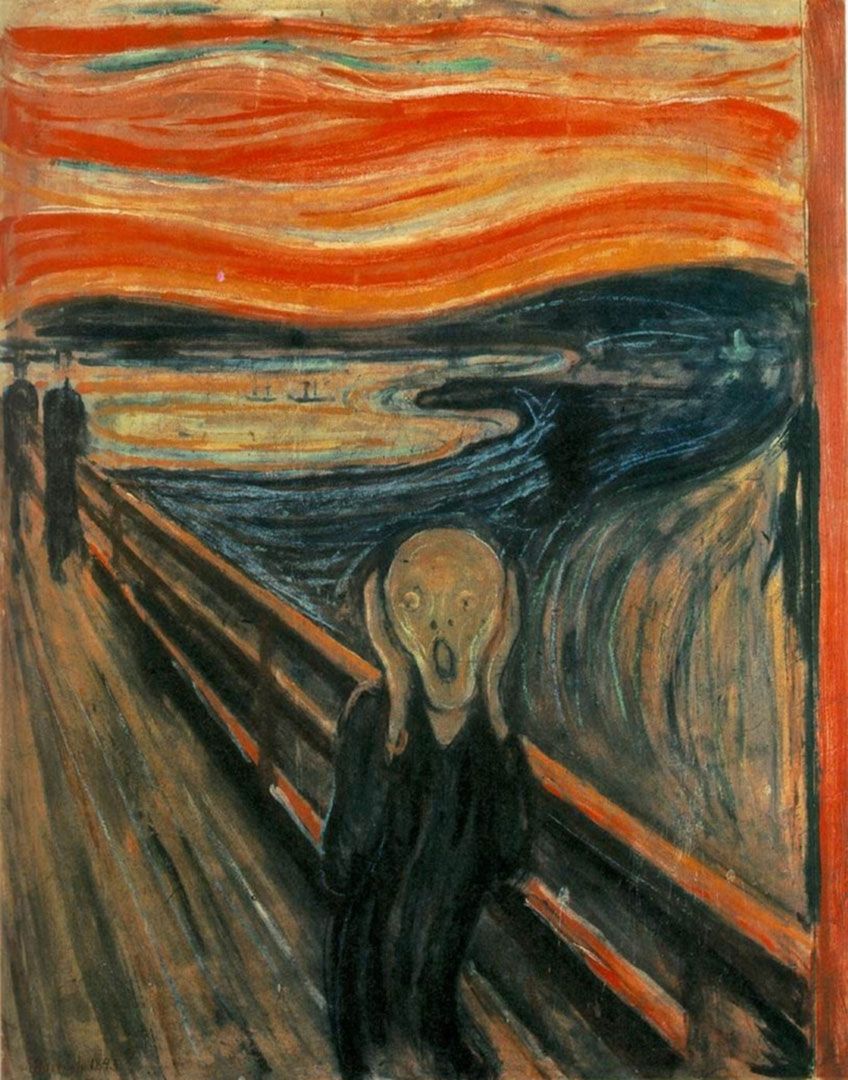
Some other artists took these aforementioned principles of expression through colour and texture and explored them even further, not being afraid to actually distort the subject in social club to truly convey their subjective experience of reality. They called it Expressionism.
,_oil_on_canvas,_71.1_x_55.9_cm,_Tate_Modern,_London.jpg)
Then, more artists, and some of the same, decided to go and also explore the subjectivity of life and existence, only by distorting the fourth dimension continuum, merging past with present and future in a visual fashion. Trippy stuff, correct? That's Cubism for yous.

Also, remember the Industrial Revolution? Technological growth was exponential, and so was people's fascination for it. This group of guys picked up cubism's concept of time bending and prized the future's aesthetics as the just affair that mattered.
Speed, technology, youth, violence, industrialism, nationalism, you lot name it, Futurists were into it.
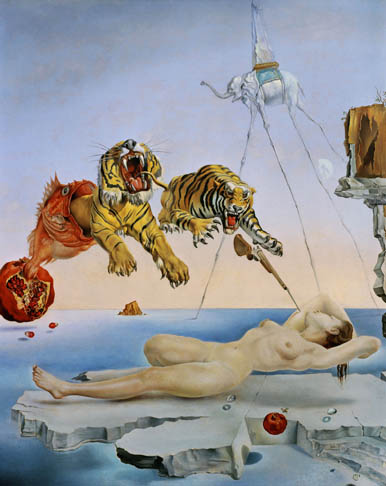
Already Surrealism was all about getting into those shiny make new Freudian theories which resulted in some pretty interesting explorations of the hidden.
Some would exercise it through their technique, similarly to the expressionists, some would do it by recording their offset thoughts afterward waking up from a dream, some would just go for drawing the first thing that would cantankerous their heed, in an attempt to human activity as unconsciously every bit possible whilst awake.
Basically, the idea was to have self-expression to the next level of getting all the potentially embarrassing and truly deep stuff out there.
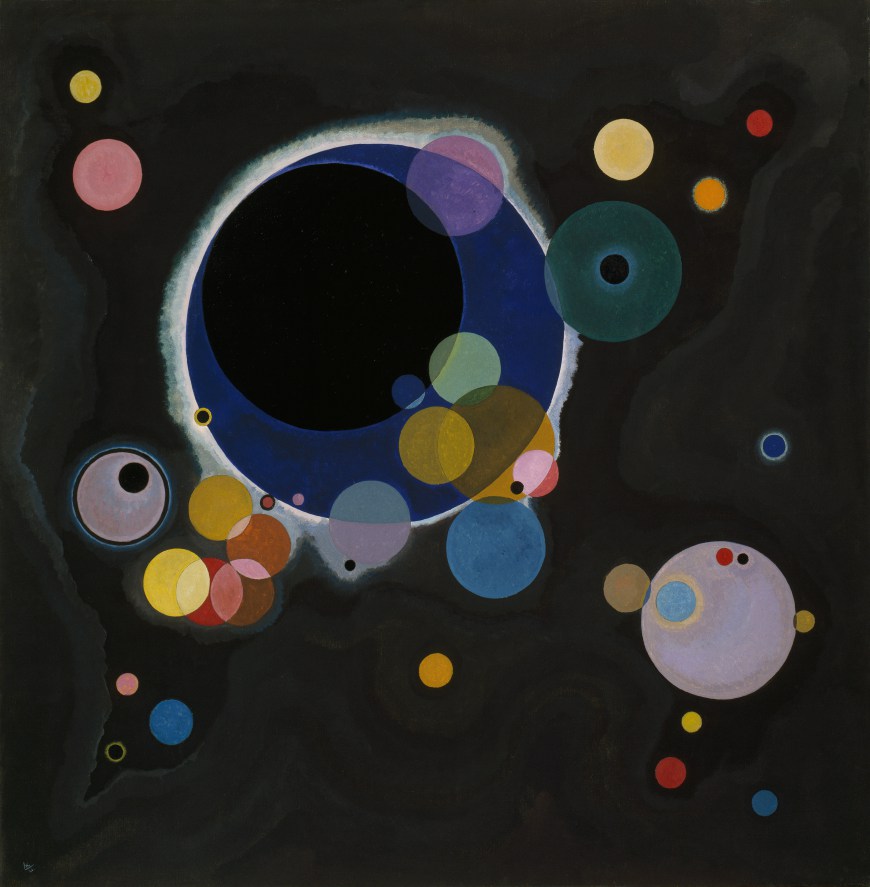
These explorations went on and on until some reached absolute abstraction. Some artists, like Kandinsky who was a musician himself, got inspired by the possibility of shapes and associative color resounding in one's cocky.

In the middle of this cluster of art movements, along came Dadaists for the necessary reality bank check, to keep everyone on their toes. They pretty much questioned everything art-related, the hardcore way.
Imagine the following: it's 1917 and at that place's a sculpture in the middle of an exhibition that is named "Fountain" and it is basically a laying urinal. The visitors didn't take it lightly and got very angry. Probably, that was exactly the point.
Dadaists forced everyone to question aesthetics and beauty, bankrupt constraints, revolted against elitism and separated words from their pregnant. Ultimately, they fabricated everyone remember almost the definition of art, and how perchance "dazzler" and "harmony" weren't necessarily requisites.
This same questioning of the thought of harmony and classical dazzler extended to all fields of fine art, by the style. I've focused virtually of the examples and history in painting, but simply because information technology is the easiest to exemplify and compare in an commodity.
But many interesting things happened in music, like how all of a sudden you could pause the scales and friction match notes that before would exist considered an awful combination. Dancing wasn't and so focused on elegance anymore, and allowed itself to exist raw and unpleasant when it was warranted.
Hither'southward a adept example of mold-breaking with Pina Bausch's dance interpretation of Igor Stravinsky's Rite of Spring.
Breaking the molds of classical and romantic aesthetics came to be a keen way of having admission to a broader range of emotions, ideas, and means of expression.
So as time passed, at that place was an exponential growth in art product and, consequently, in the number of art movements and streams of thought. So many that people just started calling information technology Contemporary Art, since the term refers to the art which is produced at the present menstruum of time.
In that location were dozens, if not hundreds, of artistic movements happening, but one that came around that time and is worth mentioning was "Conceptual Art": the thought or concept is the virtually important aspect of the piece of work.
After many centuries focused on execution, hither it became devil-may-care and superfluous, and the focus was on the planning and conclusion making washed beforehand.

One good case of Conceptual Fine art is the 1988 Maurizio Bolognini's installation art "Programmed Machines", where personal computers were programmed to generate flows of continuously expanding random images and left to run advertisement infinitum (most of these are even so working now).
Determination
When existence confronted with such kind of art pieces, it would be the moment where typically everyone rolls their eyes and hates on Contemporary Art.
Hopefully, I've managed to pass plenty information to at to the lowest degree make yous think twice instead of immediately dismissing such works. And truthfully, I promise I managed to open your minds and help yous understand that art doesn't have to be pretty or pleasant to feel.
Art doesn't need to exist a securely emotional or intellectual feel that immediately sweeps you off your feet. If annihilation, the experience you lot take with art depends more than on how you choose to interact with information technology, than on its own characteristics.
Y'all bring along all your knowledge and life baggage and, in the end, enjoying art will be your own subjective experience, and yous cull how deep y'all want to become.
"Art begins when a man, with the purpose of communicating to other people a feeling he in one case experienced, calls it upwards again within himself and expresses it by sure external signs." - 1897 / What is art by Tolstoy, p.38
"Nosotros all know that art is non truth. Art is a lie that makes the states realize truth."
-1972 / Pablo Picasso quoted in Dore Ashton's Picasso on Art
"Ideas alone tin be works of art… All ideas need not be made concrete… A work of fine art may be understood as a conductor from the artist'southward heed to the viewer's. Simply it may never achieve the viewer, or it may never leave the artist's listen." - 1994 / Sol LeWitt quoted in Fine art and Its Significance by Stephen David Ross
"Whether Mr. Mutt with his own hands made the fountain or not has no importance. He chose it. He took an ordinary article of life, placed information technology so that its useful significance disappeared under a new title and point of view (and) created a new thought for the object." - 1917 / The Blind Human being, 2nd issue, by Marcel Duchamp, Beatrice Woods and Henri-Pierre Roché

Establish this article useful? You might like these ones as well!
- Minimalism or Brutalism: which 1 to pick?
- Nosotros need to calm our technology down
- Presenting Service Pattern and why yous should care most it
Source: https://www.imaginarycloud.com/blog/the-subjective-experience-of-enjoying-art/
0 Response to "What Does It Mean to Say That Art Is Subjective? Select the Best Answer"
Post a Comment